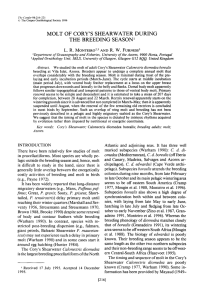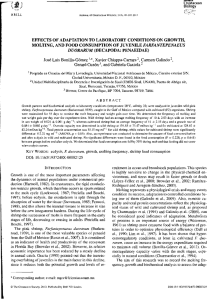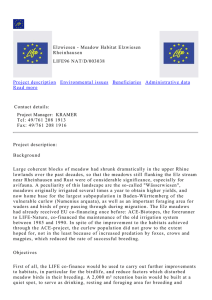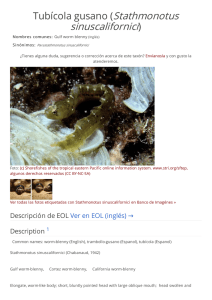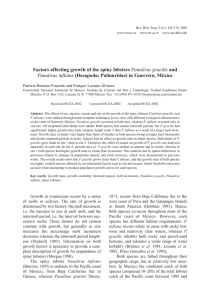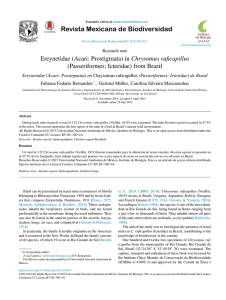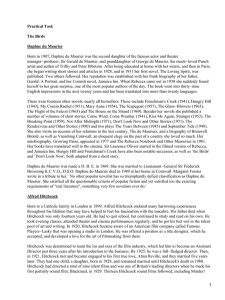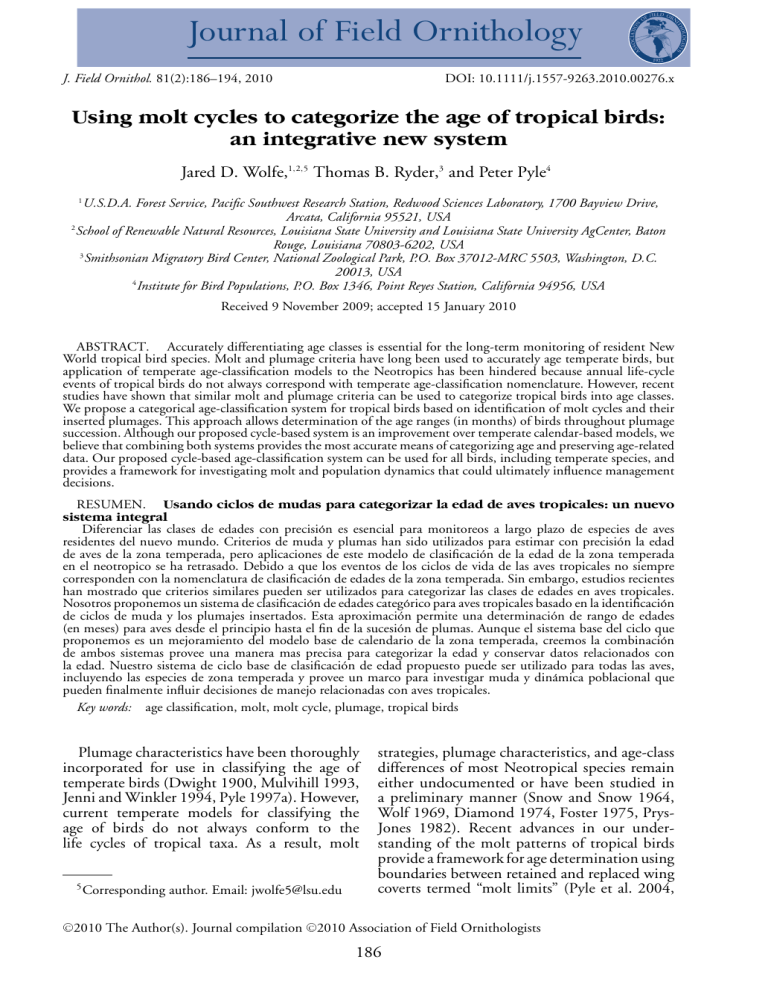
Journal of Field Ornithology J. Field Ornithol. 81(2):186–194, 2010 DOI: 10.1111/j.1557-9263.2010.00276.x Using molt cycles to categorize the age of tropical birds: an integrative new system Jared D. Wolfe,1,2,5 Thomas B. Ryder,3 and Peter Pyle4 1 U.S.D.A. Forest Service, Pacific Southwest Research Station, Redwood Sciences Laboratory, 1700 Bayview Drive, Arcata, California 95521, USA 2 School of Renewable Natural Resources, Louisiana State University and Louisiana State University AgCenter, Baton Rouge, Louisiana 70803-6202, USA 3 Smithsonian Migratory Bird Center, National Zoological Park, P.O. Box 37012-MRC 5503, Washington, D.C. 20013, USA 4 Institute for Bird Populations, P.O. Box 1346, Point Reyes Station, California 94956, USA Received 9 November 2009; accepted 15 January 2010 ABSTRACT. Accurately differentiating age classes is essential for the long-term monitoring of resident New World tropical bird species. Molt and plumage criteria have long been used to accurately age temperate birds, but application of temperate age-classification models to the Neotropics has been hindered because annual life-cycle events of tropical birds do not always correspond with temperate age-classification nomenclature. However, recent studies have shown that similar molt and plumage criteria can be used to categorize tropical birds into age classes. We propose a categorical age-classification system for tropical birds based on identification of molt cycles and their inserted plumages. This approach allows determination of the age ranges (in months) of birds throughout plumage succession. Although our proposed cycle-based system is an improvement over temperate calendar-based models, we believe that combining both systems provides the most accurate means of categorizing age and preserving age-related data. Our proposed cycle-based age-classification system can be used for all birds, including temperate species, and provides a framework for investigating molt and population dynamics that could ultimately influence management decisions. RESUMEN. Usando ciclos de mudas para categorizar la edad de aves tropicales: un nuevo sistema integral Diferenciar las clases de edades con precisión es esencial para monitoreos a largo plazo de especies de aves residentes del nuevo mundo. Criterios de muda y plumas han sido utilizados para estimar con precisión la edad de aves de la zona temperada, pero aplicaciones de este modelo de clasificación de la edad de la zona temperada en el neotropico se ha retrasado. Debido a que los eventos de los ciclos de vida de las aves tropicales no siempre corresponden con la nomenclatura de clasificación de edades de la zona temperada. Sin embargo, estudios recientes han mostrado que criterios similares pueden ser utilizados para categorizar las clases de edades en aves tropicales. Nosotros proponemos un sistema de clasificación de edades categórico para aves tropicales basado en la identificación de ciclos de muda y los plumajes insertados. Esta aproximación permite una determinación de rango de edades (en meses) para aves desde el principio hasta el fin de la sucesión de plumas. Aunque el sistema base del ciclo que proponemos es un mejoramiento del modelo base de calendario de la zona temperada, creemos la combinación de ambos sistemas provee una manera mas precisa para categorizar la edad y conservar datos relacionados con la edad. Nuestro sistema de ciclo base de clasificación de edad propuesto puede ser utilizado para todas las aves, incluyendo las especies de zona temperada y provee un marco para investigar muda y dinámica poblacional que pueden finalmente influir decisiones de manejo relacionadas con aves tropicales. Key words: age classification, molt, molt cycle, plumage, tropical birds Plumage characteristics have been thoroughly incorporated for use in classifying the age of temperate birds (Dwight 1900, Mulvihill 1993, Jenni and Winkler 1994, Pyle 1997a). However, current temperate models for classifying the age of birds do not always conform to the life cycles of tropical taxa. As a result, molt 5 Corresponding author. Email: jwolfe5@lsu.edu C 2010 strategies, plumage characteristics, and age-class differences of most Neotropical species remain either undocumented or have been studied in a preliminary manner (Snow and Snow 1964, Wolf 1969, Diamond 1974, Foster 1975, PrysJones 1982). Recent advances in our understanding of the molt patterns of tropical birds provide a framework for age determination using boundaries between retained and replaced wing coverts termed “molt limits” (Pyle et al. 2004, C 2010 Association of Field Ornithologists The Author(s). Journal compilation 186 Vol. 81, No. 2 Molt-Cycle Age-Categorization System 187 Fig. 1. A temperate-tropical comparison of annual life history events for two seedeaters in the genus Sporophila (Aves: Emberizidae) exemplifying the prolonged tropical breeding season, sometimes overlapping 1 January, characteristic of some passerines at southern latitudes (Pyle 1997b, Wolfe et al. 2009). Ryder and Durães 2005, Ryder and Wolfe 2009, Wolfe et al. 2009). Many tropical land bird species have incomplete or partial molts immediately following the prejuvenile molt, resulting in distinguishable molt limits and thereby facilitating age recognition. A popular system for age-classification of temperate birds relies on a calendar-based ageclassification system that uses hatching date relative to 1 January (Pyle 1997b). With this system, an individual in its calendar year of hatching is termed “hatching year” (HY) and older birds are termed “after hatching year” (AHY) until 1 January, when these individuals become “second year” (SY) and “after secondyear” (ASY), respectively. Importantly, the calendar-based ageclassification system cannot be used to categorize the age of species that breed across 1 January. When breeding seasons overlap 1 January, the calendar-based age-classification system cannot accurately discriminate cohorts (Snow 1976, Wolfe et al. 2009; Fig. 1). Here we refer to this inherent problem as the “calendar dilemma.” To mitigate the calendar dilemma, we have considered two modifications to the calendarbased age-classification system in tropical latitudes: (1) determining, on a species-by-species basis, whether or not the breeding season peaks before or after 1 January and, depending on when most individuals breed, categorically 188 J. D. Wolfe et al. placing all birds of each species in the same age class, or (2) redefining a separate calendar date (other than 1 January) on which all age codes of a given species changes. These two proposed solutions do not solve the calendar dilemma for species with biannual breeding distributions (Wolfe et al. 2009), eruptive breeders (Snow and Snow 1964, Diamond 1974), or those species in lowland equatorial regions that show little or no seasonality in breeding. Our proposed solution is to use molt cycles and their inserted plumages, which are assumed to be homologous across all taxa, as a means of classifying age. Our objective was to provide a coding system based on molts and plumages that, when combined with other information, can be used to accurately designate cohorts, thereby eliminating the calendar dilemma. DEFINING AND IDENTIFYING MOLT CYCLES Following Humphrey and Parkes (1959; hereafter, H-P), molt and plumage cycles are based on presumably ancestral prebasic molts and evolved inserted molts. Prebasic molts are regular (often annual) events that typically adhere to well-defined periods, even for tropical species with prolonged breeding seasons (Foster 1975, Prys-Jones 1982, Stutchbury and Morton 2001, Pyle et al. 2004). Humphrey and Parkes (1959) were implicit in associating plumage with age. Here, we explicitly anchor plumage to age using updated terminology (Howell et al. 2003). The assumption of plumage homology following the H-P system, and recent proposed revisions (Howell and Corben 2000, Howell et al. 2003), have resulted in useful nomenclature that can be incorporated into age-classification systems. Howell et al.’s (2003) revision was rooted in the assumption that juvenal plumage is homologous to later basic plumages. Howell et al. (2003) thus redefined the “prejuvenal molt” as the “first prebasic molt” and replaced what was formerly considered the “first prebasic molt” of most species with the “preformative molt” (Fig. 2). This inserted molt produces the “formative plumage” and lacks homologous counterparts in later age groups. Using this terminology, molt cycles are defined based on prebasic molts. Therefore, the “first molt cycle” can be defined as the period from the beginning of the first prebasic J. Field Ornithol. (prejuvenal) molt until the beginning of the second prebasic molt, and subsequent cycles are similarly determined through the “definitive molt cycle” when plumage no longer changes with successive homologous molts. The benefits of Howell et al.’s (2003) revision of the H-P system include the assumed homologous initiation of the first molt and plumage cycles, an important step for establishing nonambiguous nomenclature. Familiarity with molt limits, retained juvenal plumage, feather shape, feather wear, and other essential plumage characteristics (cf. Mulvihill 1993; Pyle 1997a, b) facilitates precise moltcycle determination. For example, many tropical oscines and suboscines in their first molt cycle (i.e., in juvenal, formative, or first alternate plumages) can be distinguished from older birds in definitive molt cycles (i.e., definitive basic or alternate plumages). However, correctly differentiating a formative plumage following a complete molt from subsequent basic plumages is usually not possible (cf. Pyle 1997b). For example, several tropical genera in the family Thamnophilidae (e.g., Gymnopithys, Rhegmatorhina, Sclateria, Pyriglena, and Phlegopsis) include species that undergo complete preformative molts (Ryder and Wolfe 2009). In addition, there are species that undergo eccentric preformative molts where inner primaries are replaced, for example, genera within Thamnophilidae (Cymbiliamus, Pygptila, and Microphias), and some species of Myrmoborus, Formicivora, and Cercromacra (Ryder and Wolfe 2009). Without knowledge of molt extent, biologists could potentially mistake an eccentric preformative for a definitive prebasic molt. Distinguishing plumages in later molt cycles (e.g., second basic from definitive basic plumages) is also not possible for most oscines and suboscines, although identification of some second-cycle, third-cycle, and fourth-cycle nonpasserines, such as gulls and certain raptors, is possible by examining plumage and flight-feather molt patterns and using other criteria (Pyle 2008). USING MOLT CYCLES TO AGE TROPICAL BIRDS With our cycle-based age-classification system, initiation of prebasic primary molt is the definitive marker that indicates advancement in molt cycle. Thus, for most oscines and Vol. 81, No. 2 Molt-Cycle Age-Categorization System 189 Fig. 2. (A) Comparison of the standard Humphrey and Parkes (H-P; 1959) system and the Complex Basic Strategy (CBS), as described by Howell et al. (2003). (B) Comparison of the standard H-P system and the Complex Alternate Strategy (CAS) as described by Howell et al. (2003). Appropriate cycle-based age-classification codes are placed next to their corresponding molt and plumage categories in the Howell et al. (2003) schematic. 190 J. D. Wolfe et al. J. Field Ornithol. Fig. 2. Continued. suboscines, one molt cycle ends and the succeeding cycle is initiated when the first primary (P1) is shed (molt can initiate with other primaries in larger birds with alternate remigial-replacement strategies; cf. Pyle 2006, 2008, Rohwer et al. 2009). Even though initiation of body-feather replacement may precede that of flight-feather replacement, determining if body-feather Vol. 81, No. 2 Molt-Cycle Age-Categorization System 191 Table 1. Comparison of common equivalent age codes in the cycle-based age-classification system and the calendar-based age-classification system for the first, second, and definitive molt cycles. The calendar-based age codes are currently recognized by the Bird Banding Laboratory (USGS). Cycle-based age-classification system UCU Unknown molt cycle, unknown plumage UCB Unknown molt cycle, basic plumage UCA Unknown molt cycle, alternate plumage UCS Unknown molt cycle, supplemental plumage FCJ First molt cycle, juvenal plumage FCF First molt cycle, formative plumage FCA First molt cycle, alternate plumage FCS First molt cycle, supplemental plumage SCB Second molt cycle, basic plumage SCA Second molt cycle, alternate plumage SCS Second molt cycle, supplemental plumage DCB Definitive molt cycle, basic plumage DCA Definitive molt cycle, alternate plumage DCS Definitive molt cycle, supplemental plumage replacement is representative of a prebasic molt, an inserted molt, or replacement of accidentally lost feathers is often difficult. Thus, the symmetrical shedding of P1 (or other primaries during certain molts in larger birds) represents an unambiguous marker for the succession of molt cycles. Within molt cycles, however, the initiation of body-feather replacement (e.g., as part of preformative, prealternate, or presupplemental molts) is treated as a marker for succeeding plumages. The first step in using our cycle-based ageclassification system is to define the molt cycle as either the first (FC), second (SC), third (TC), fourth (4C), and so on, or definitive (DC) cycle. For many oscines and suboscines, the second basic plumage equates to definitive basic plumage. However, it can be coded as SC during the period of the second prebasic molt, provided that this molt can be recognized as such. Once a bird has been identified as being in its first cycle, its plumage can then be defined as juvenal (J), formative (F), alternate (A), or supplemental (S). We use “juvenal” as opposed to “first basic” for this initial plumage, as suggested by Howell et al. (2003), due to the familiarity and wide use of the term juvenal. Thus, a firstcycle individual in complete juvenal plumage is coded FCJ and, once a preformative molt begins, is coded FCF. Other possible plumages within the first cycle include first alternate (FCA) and first supplemental (FCS), although these are not commonly encountered in tropical oscines and Calendar-based age-classification system U or AHY Unknown or after hatching year U or AHY Unknown or after hatching year U or AHY Unknown or after hatching year U or AHY Unknown or after hatching year HY or SY Hatch year or second year HY or SY Hatch year or second year SY Second year SY Second year SY or TY Second year or third year TY Third year TY Third year TY or ATY Third year or after third year ATY After third year ATY After third year suboscines. Individuals in their second cycle can be recorded as basic (SCB), alternate (SCA), or supplemental (SCS), and the same plumages can be found in the third (TCB, TCA, or TCS), fourth (4CB, 4CA, or 4CS), and so on, and definitive (DCB, DCA, or DCS) cycles. As with the calendar-based age-classification system, acknowledging uncertainty when using the cycle-based age-classification system will be important. The unknown code “UCU” is proposed for cases where both the cycle and the plumage within the cycle are unknown (Table 1). If the plumage is known (i.e., basic, alternate, or supplemental), but the molt cycle is undetermined, plumage-specific unknown codes (UCB, UCA, or UCS) can be used. Alternatively, when the molt cycle is known (i.e., first, second, or third), but the plumage is undetermined, cyclespecific unknown codes (FCU, SCU, DCU, and so on) can be used. An age bracket, or age in months during which individuals may start or end a particular molt, can be coupled with each determined cycle-based age code for each species, thereby providing an estimation of age in months for each individual. Age brackets, especially for tropical birds, will be perpetually refined as the results of more studies of bird molt become available. Due to intraspecific temporal variation in the duration of juvenal plumage, age brackets of juvenal and formative plumages typically overlap to encompass a margin of error. In addition, species with inserted molts (e.g., J. D. Wolfe et al. 192 prealternate or supplemental molt) provide greater refinement in the cycle-based ageclassification system due to the greater number of plumages within a cycle, which refines age brackets. Similarly, the cycle-based ageclassification system expands upon the utility of “unknown” codes by utilizing specific unknown plumage or molt cycle codes (i.e., FCU, SCU, and TCU, or UCB, UCA, and UCS; Table 1). As such, molt cycles and associated age brackets provide a robust, noncalendar-based age classification system for tropical birds. CASE STUDY As an example of the utility of integrating plumage cycles and age classification systems, consider five Variable Seedeaters (Sporophila americana) captured in Tortugero, Costa Rica. Four individuals were captured between 19 and 28 February 2005, and the remaining individual on 30 April 2005. All five individuals had mixed juvenal and formative feathering, indicating that they were in their first cycle. The four birds captured in February had no alternate feathers, but the individual captured in April was undergoing the first prealternate molt (Wolfe et al. 2009). Using the calendar-based age-classification system, classifying the correct age of the five Variable Seedeaters was difficult because it was impossible to determine if they hatched before or after 1 January 2005. Given the variability in the duration of the juvenal, formative and alternate plumages, determining if they were hatching-year or a second-year birds was difficult so they were classified as “unknown.” Recognizing that the four seedeaters captured in February were in formative plumage, they could be classified as FCF using the cycle-based age-classification system. Because the formative phase occurs prior to the first prealternate molt in the Complex Alternate Strategy (Fig. 2), the associated age bracket is more refined for species adhering to the Complex Basic Strategy (Fig 2). Thus, the associated age bracket for this species indicates that the four seedeaters captured in February were between 1 and 8 mo old. The seedeater undergoing its first prealternate molt when captured in April had passed the formative and entered the alternate phase of the first molt cycle. Thus, it could be classified as FCA and J. Field Ornithol. the associated age bracket indicates that it was between 7 and 12 mo old. Several groups of temperate birds are also subject to the calendar dilemma. For example, a Red Crossbill (Loxia curvirostra) was captured by Klamath Demographic Monitoring Network cooperators in northern California on 1 July 2005. This crossbill had mixed juvenal and formative feathering, indicating that it was in formative plumage. Red Crossbills can breed across 1 January (Pyle 1997b) so, not knowing whether it had hatched before or after 1 January 2005, determining the correct age of the crossbill was difficult using the calendar-based ageclassification system. As a result, the crossbill’s age was classified as “unknown.” However, recognizing that the captured crossbill was in formative plumage, it could be classified as FCF using the cycle-based ageclassification system. Because the formative phase occurs prior to the definitive basic molt in the Complex Basic Strategy (Fig. 2), the associated age bracket is generally less refined for species adhering to the Complex Alternate Strategy (Fig 2). Thus, the associated age bracket for Red Crossbills indicates that an individual captured in formative plumage is between one and 12 mo old. DISCUSSION Despite a growing interest in the population dynamics of Neotropical landbirds, no robust and widely applicable technique has been used for age categorization of tropical taxa. Here, we have presented a cycle-based ageclassification system that derives conclusions through plumage and molt patterns, while providing repeatable assignment of age classes. The accuracy and ultimate value of the cyclebased age-classification system is dependent on the knowledge of the practitioner and available molt data for tropical birds. Recent studies indicate that molt strategies of tropical birds are similar to those of temperate birds (Pyle et al. 2004, Ryder and Durães 2005, Ryder and Wolfe 2009, Wolfe et al. 2009) and that many tropical oscines and suboscines, like many temperate oscines and suboscines, have incomplete or partial preformative molts (Dickey and van Rossem 1938, Wolfe et al. 2009). Thus, plumage criteria can be useful for classifying age for most tropical species. Vol. 81, No. 2 Molt-Cycle Age-Categorization System Although our cycle-based age-classification system is an improvement over the calendarbased age-classification system when assigning tropical birds to age classes, several problems need to be addressed. Specifically, the novel nature of the cycle-based age-classification system coupled with the potential for complex and protracted molt strategies in tropical birds will present initial challenges. For example, some tropical species can potentially undergo an annual molt lasting up to 4 to 6 mo and can exhibit individual variation in timing (both start and completion dates) of up to 2 mo, even within a population, leaving a 2 mo margin of error within each molt cycle. These situations would result in individuals of the same age being placed into different molt cycles, or birds of different ages being given the same cycle-based age-class code. For example, an individual that is 1-mo old and has just begun the preformative molt and an individual over a-year-old that has not begun the second prebasic molt would both be coded “FCF” even though they belonged to different cohorts. If age brackets include the necessary margins of error for such cases, this problem can be alleviated. Conversely, codes and associated age brackets reflecting individuals undergoing molt can be generated for species with protracted molts. Another solution to the above situation includes using the cycle-based age-classification system in combination with the calendar-based age-classification system. In the above example, the calendar-based age-classification system might age the first bird as an HY individual and the second bird as an SY individual, thus preserving cohort information, whereas the addition of the cycle-based age-classification system code (FCF) indicates that both individuals were in the same plumage. Combining the two systems ultimately provides the most accurate means of categorizing age and preserving age-related data. Additionally, cycle-based age-classification system codes can be combined with information concerning skull ossification, molt status, and primary wear to further alleviate this problem and narrow assigned age brackets. To date, our ability to age birds in tropical regions has been hindered by our inability to accurately apply temperate age-classification systems to tropical birds. Our cycle-based ageclassification system provides the theoretical frame-work necessary to assign birds into age classes that are reflective of their life-cycle, not 193 a calendar date. As additional studies of the duration and timing of molt of tropical birds are conducted, the age brackets and utilitarian value of the cycle-based age-classification system will likely improve. These modifications to the traditional temperate classification models should be applied to population-level studies in the tropics while they are still in their initial stages. By increasing the accuracy of age categorization, we enhance our ability to understand demographics and that will ultimately improve our ability to effectively manage populations. We also believe that our system will further refine age classification of temperate species and enhance our understanding of avian molt patterns. ACKNOWLEDGMENTS Special thanks to L. Wolfe and D. Wilde for their help with figure formatting. Thanks also to personnel at the Klamath Bird Observatory, Institute for Bird Populations, Point Reyes Bird Observatory, and Redwood Sciences Laboratory. Special thanks to C.J. Ralph, D. and C. Romo, K. Swing, J. Guerra, E. Johnson and all the staff at the Tiputini Biodiversity Station and Caribbean Conservation Corporation for their tireless logistical and field support. IACUC protocol number 5-12-20. This research was conducted in accordance with permit number 13IC-FAUDFN, Ministerio de Ambiente, Distrito Forestal Napo, Tena, Ecuador. We thank them for allowing us to conduct our research at the Tiputini Biodiversity Station. Funding was provided by the International Center for Tropical Ecology, AFO’s Alexander Bergstrom Award, National Geographic Society (7113-01), and National Science Foundation (IBN 0235141, IOB 0508189, OISE 0513341). This is contribution #386 of the Institute for Bird Populations. This is also a contribution of Land Bird Monitoring of the Americas (LaMNA) and the Tortuguero Integrated Bird Monitoring Project (TIBMP). LITERATURE CITED DICKEY, D. R., AND A. J. VAN ROSSEM. 1938. The birds of El Salvador. Field Museum of Natural History Zoological Series 23: 1–609. DIAMOND, A. W. 1974. Annual cycles in Jamaican forest birds. Journal of Zoology 173: 277–301. DWIGHT, J. 1900. The sequence of plumages and moults of the passerine birds of New York. Annals of the New York Academy of Sciences 13: 73–360. FOSTER, M. S. 1975. The overlap of molt and breeding in some tropical birds. Condor 77: 304–314. HOWELL, S. N. G., AND C. CORBEN. 2000. A commentary on molt and plumage terminology: implications from the Western Gull. Western Birds 31: 50–56. HOWELL, S. N. G., C. CORBEN, P. PYLE, AND D. I. ROGERS. 2003. The first basic problem: a review of molt and plumage homologies. Condor 105: 635– 653. 194 J. D. Wolfe et al. HUMPHREY, P. S., AND K. C. PARKES. 1959. An approach to the study of molts and plumages. AUK 76: 1– 31. JENNI, L., AND R. WINKLER. 1994. Moult and ageing of European passerines. Academic Press, New York, NY. MULVIHILL, R. S. 1993. Using wing molt to age passerines. North American Bird Bander 18: 1–10. PRYS-JONES, R. P. 1982. Molt and weight of some landbirds on Dominica, West Indies. Journal of Field Ornithology 53: 352–362. PYLE, P. 1997a. Molt limits in North American passerines. North American Bird Bander 22: 49–90. ———. 1997b. Identification guide to North American birds. Part 1. Slate Creek Press, Bolinas, CA. ———. 2006. Staffelmauser and other adaptive strategies for wing molt in larger birds. Western Birds 37: 179– 185. ———. 2008. Identification guide to North American birds. Part 2. Slate Creek Press, Point Reyes Station, CA. PYLE, P., A. MCANDREWS, P. VELÉZ, R. L. WILKERSON, R. B. SIEGEL, AND D. F. DESANTE. 2004. Molt patterns and age and sex determination of selected southeastern Cuban landbirds. Journal of Field Ornithology 75: 136–145. ROHWER, S., R. E. RICKLEFS, V. G. ROHWER, AND M. M. J. Field Ornithol. COPPLE. 2009. Allometry of the duration of flight feather molt in birds. PLoS Biology 7: 1–9. RYDER, T. B., AND R. DURÃES. 2005. It’s not easy being green: using molt limits to age and sex green plumage manakins (Aves: Pipridae). Ornitologia Neotropical 16: 481–491. RYDER, T. B., AND J. D. WOLFE. 2009. The current state of knowledge on molt and plumage sequences in selected Neotropical bird families: a review. Ornitologia Neotropical 20: 1–18. SNOW, D. W., AND B. K. SNOW. 1964. Breeding seasons and annual cycles of Trinidad landbirds. Zoologica 49: 1–39. SNOW, D. W. 1976. The relationship between climate and annual cycles in the Cotingidae. IBIS 118: 366– 401. STUTCHBURY, B. J. M., AND E. S. MORTON. 2001. Behavioral ecology of tropical birds. Academic Press, San Diego, CA. WOLF, L. L. 1969. Breeding and molting periods in a Costa Rican population of the Andean Sparrow. Condor 71: 212–219. WOLFE, J. D., P., PYLE, AND C. J. RALPH. 2009. Breeding seasons, molt patterns, and gender and age criteria for selected northeastern Costa Rican resident landbirds. Wilson Journal of Ornithology 121: 556–567.
